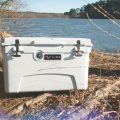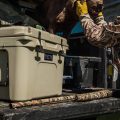Last Updated on August 1, 2023 by Dean Anderson
Your cooler is one of the most important parts of your camping gear.
If you don’t have good food, you won’t last very long.
Before you prepare for your next camping trip, make sure you take a look at this guide and learn all there is to know about top coolers.
The Different Kinds of Coolers
Not all coolers are made the same. Though there are a lot of different kinds of coolers out there, not all of them are suited for camping trips. You’ll want to make sure the top coolers you choose will actually keep your food at the right temperature before driving away from home.
Soft Sided Coolers
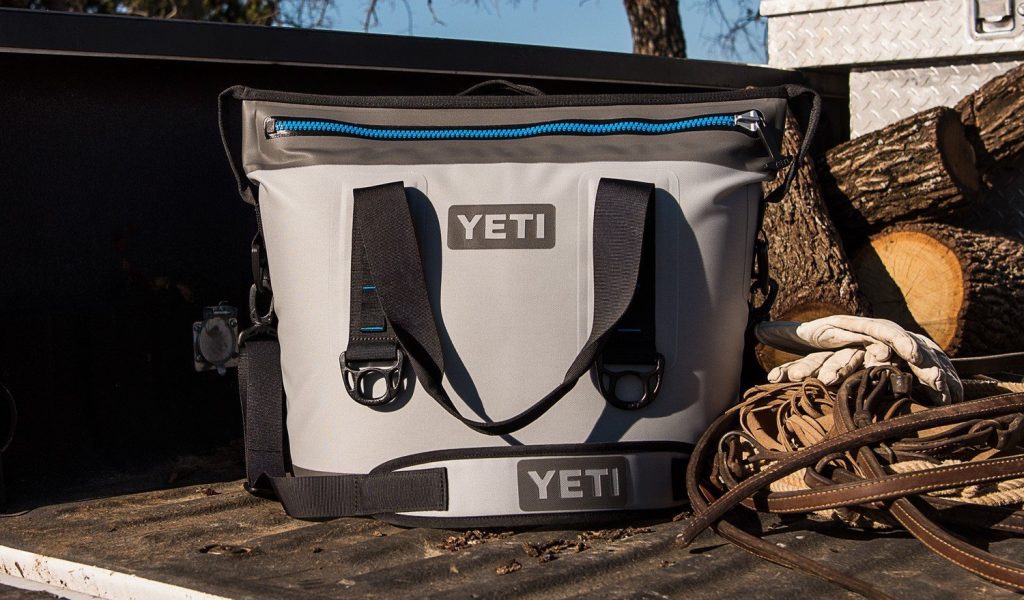
These are not the best camping coolers unless you’re talking about the expensive Yeti variety. Most soft coolers are made of fabric, and they aren’t designed to keep food cool for more than one day. If all you need a cooler for is a day at the beach every once in a while, soft coolers will do fine. Any trip longer than that needs a better cooler.
That said, soft coolers can come in handy during your camping trip as a secondary cooler. If you spend a lot of time away from your campsite, you can pack lunch or drinks in a soft cooler and bring it along with you. Most are small, easy to transport, and can be carried over the shoulder or like a backpack.
Electric Coolers
This kind of cooler isn’t practical for campsites either (unless your campsite miraculously has an outlet).
Electric coolers are more like little refrigerators. They plug into the wall, or in some cases the car, and keep your food cool with electricity by maintaining a vacuum in the internal space. Because you don’t have to fill it with ice or drain it, this kind of cooler can remove a lot of hassle from your trip. The walls of these don’t tend to be as thick and therefore ice retention isn’t quite as good.
If you’re staying at a hotel and want to bring your own food along or have a long drive ahead of you, this cooler is a good choice.
Plastic Cooler
 Plastic coolers including the more premium rotomolded kind can keep your food cool for multiple days at a time without you putting in new ice, making them some of the top coolers for camping trips. But the exact time-frame they can stay cool depends on the size (something we get into a little later).
Plastic coolers including the more premium rotomolded kind can keep your food cool for multiple days at a time without you putting in new ice, making them some of the top coolers for camping trips. But the exact time-frame they can stay cool depends on the size (something we get into a little later).
The plastic makes these coolers durable, so they can take a good amount of roughing up and still last for years. If you’re planning a multiple day getaway, a plastic cooler is a cooler you’ll want and better brands can keep ice for up to 10 days.
Metal Coolers
These are even more heavy duty than plastic coolers. Metal coolers are usually used by people like fishermen or hunters who need very durable coolers.
The metal covering protects the insulation well, but it does make the cooler heavier than plastic coolers. Metal coolers also tend to be more expensive than other coolers though there are exceptions to the rule like the retro ones from camping giant Coleman.
So unless you’re going on an intense camping trip that will include a lot of meat, you should probably stick to a plastic cooler.
High-End Coolers vs. Traditional Coolers
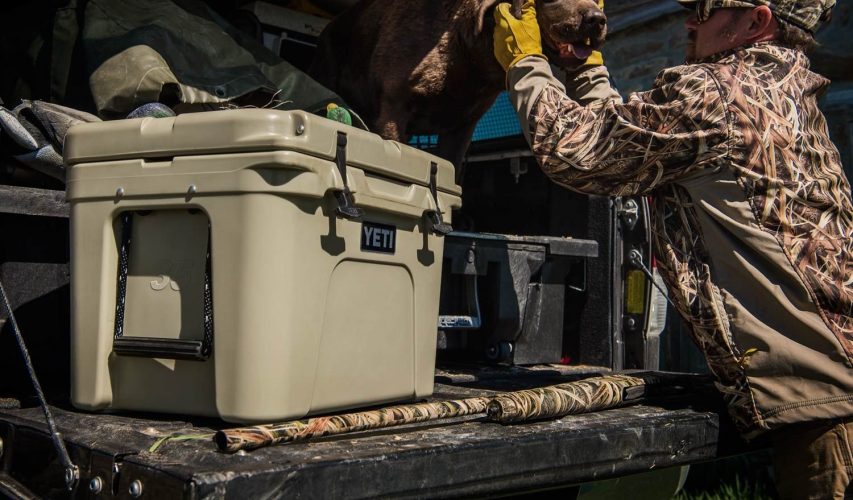 Traditional coolers are the coolers you see lining store shelves. Unless you’re planning on some heavy-duty camping trips, this is probably the kind of cooler you’ll want.
Traditional coolers are the coolers you see lining store shelves. Unless you’re planning on some heavy-duty camping trips, this is probably the kind of cooler you’ll want.
High-end coolers focus on maximizing the insulating capability with rotomolding construction techniques, meaning they can keep food cooler and retain ice for longer periods of time.
Think of brands like Orca, Igloo Yukon, Grizzly, or Yeti Tundra. They are more expensive and more durable, though good alternatives for less money are available. These are good for really long camping trips or for people planning to bring home a lot of fish or meat.
A decent cooler for the camper, fisherman or outdoors person in your life can also make a thoughtful gift.
How Cold Should I Keep My Cooler?
This depends on what you’re keeping in your cooler, but according to the U.S. Department of Health and Human Services, all perishable food should be stored at or below 40 degrees Fahrenheit.
This temperature is important because your food could spoil if it gets too warm. But your food can make you sick long before it starts to smell bad, so if you’ve stored it at the wrong temperature, you might not even be able to tell it is bad.
You don’t want to risk getting sick when you’re camping. The nearest hospital could be hours away, and it will ruin your vacation.
Traditional coolers can reliably keep food at this temperature for four to five days. If you’re planning a longer trip, you’ll want a high-end cooler.
Now, you do have a bit of leeway here.
A lot of campers like to enjoy a beer around the campfire at the end of the day, and the best beers are served cold. Beers should be kept at around 40 degrees Fahrenheit as well, but they don’t have to be that cold.
If you’re using your cooler for beers or cold drinks, the temperature doesn’t have to be as specific.
What Size Should My Cooler Be?
To figure out how big your cooler should be, you first have to know how many people will be using it and what you’ll be using it for.
If you’re camping trip just be you and one other, you won’t need anything larger than a 40 to 50-quart cooler. This will last you a weekend.
A 70-quart cooler will last two people longer than a weekend or can sustain a family for a weekend.
Bigger options are for large crowds. They are heavy and can be difficult to move, so you may want to stick to smaller coolers.
You can always mix and match coolers. Maybe you’re planning a family trip but don’t want to deal with a large cooler. You can get two or three smaller coolers instead that are easier to move. Or you may be able to downsize your food cooler if you decide to have a separate cooler for your drinks.
External Size vs. Internal Size
Keep in mind, the external size of a cooler is different from the internal size. This is especially true on more premium brands that incorporate thick insulation.
Make sure you look at the external size too. You may end up with a cooler that doesn’t quite fit in the back of your car or one that can’t store enough.
Good Features to Have
Different coolers come with different features, but there are a few things all top coolers should have.
Draining Holes
These should be at the bottom of the cooler. A draining hole higher up on the cooler will require you to tilt the entire cooler to drain the melted ice. For bigger coolers especially, that simply isn’t an option.
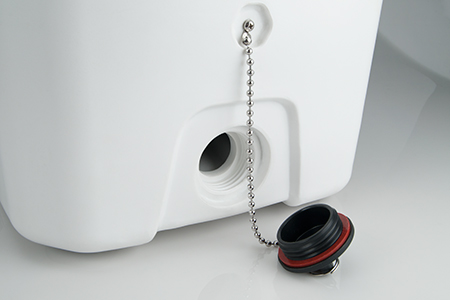 Make sure the hole isn’t so big ice cubes will drain out as well. Some brands, like Grizzly or Igloo Yukon coolers, have large holes that are supposed to speed up the draining process. Just undoing them slightly and letting them drain will avoid losing all your ice too.
Make sure the hole isn’t so big ice cubes will drain out as well. Some brands, like Grizzly or Igloo Yukon coolers, have large holes that are supposed to speed up the draining process. Just undoing them slightly and letting them drain will avoid losing all your ice too.
You should also look for top coolers that connect the drain plug to the cooler by a chain or lanyard, again the Yukon brand is good for this. If you lose the plug, your food and drink could be spoiled.
Wheels and Handles
 Most large coolers have to be carried by two people, especially if they are full. If you’re going to be handling a large cooler on your own, wheels and handles could really help you out.
Most large coolers have to be carried by two people, especially if they are full. If you’re going to be handling a large cooler on your own, wheels and handles could really help you out.
But they aren’t entirely necessary. You can drag a cooler without wheels, but the bottom will get scratched and damaged over time. Wheels just make it drag a little easier and protect the bottom from rocks and sticks.
If you’re dealing with a 100-quart cooler, you may need to drag it more than you carry it. However, because it is so large and can get so heavy, you may be better off putting it in the car at the beginning of your trip, packing it once it’s inside, and leaving it inside for the rest of the trip.
You may even be able to leave it in a wagon. Both options will make it harder to drain, but it could save you a lot of moving trouble.
Cup Holders
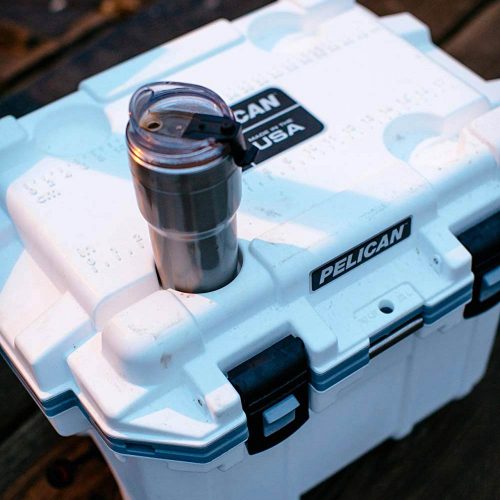 Though not necessary, this can help you keep your drinks organized and upright. It may not be of much use if your cooler isn’t in the communal gathering area (you won’t want it near the campfire or any other heat).
Though not necessary, this can help you keep your drinks organized and upright. It may not be of much use if your cooler isn’t in the communal gathering area (you won’t want it near the campfire or any other heat).
But, this could be a nice feature if you have a large party and a lot of drinks or if it sits next to you in your pickup truck..
A Few Final Tips for Top Coolers
A cooler is only helpful if you know how to pack your food and take care of it at the campsite. Here is a very quick crash course.
Back the Most Perishable Foods Lower
The bottom of the cooler is colder than the top of the cooler because that is where all the ice water melts. Therefore, make sure your most perishable foods (like meats) are at the bottom of the cooler.
Keep Out of the Sun
The sun will only make even top coolers warm up faster. If you want your food to stay cool, put your cooler in the shade.
Don’t Drain All the Water
Leaving a bit of ice water at the bottom of your cooler will keep it colder longer.
Pre-Chill Your Food
Putting warm food on ice will melt the ice, if only slightly before it gets a chance to warm up. Put all your food in the refrigerator before you pack it.
Leave the Lid Closed
Top coolers work best when they aren’t messed with. Every time open the cooler, you release a lot of cold air. Of course, you have to open your cooler, but try to keep it closed tight as much as possible.
Top Coolers Save the Trip
If you don’t have good coolers, you won’t have good food. When you’re looking for a cooler, make sure they’ll keep your food at 40 degrees or below and support the entire camping group.

Eight years ago, I took a risk and left a miserable office job to follow a lifestyle career that involved my love for the great outdoors. I’ve taken my love for camping, hiking and travel to the next level by running my small campground with a friend near Portland, Oregon. It’s for way less money but this has truly been a dream come true and the running involves lots of family and friends.
The next evolution of that was to get online and start allcampingstuff.com. At our campground, I spend a lot of time setting up camping equipment for customers and disposing of the garbage products they leave behind. If I can help just a few people with advice on good camping gear, then this website venture will be worth it.
So, if you want to avoid the duds and spend your money wisely you’ve hopefully come to the right place.


